|
|

This tutorial describes how to check and create IPX SAP connectivity requirements and modify router SAP attributes for "what-if" simulation. Checking and modifying connectivity requirements can be accomplished using the initial baseline scenario created when a baseline is opened and loaded. However, modifying router attributes for "what-if" simulation requires a new scenario to be created. This step is also described in this tutorial.
The following tasks are performed and described in this tutorial:
Step 1 From the Open Baseline window, select the tutorial_baseline baseline. Click on the OK button to load the baseline into memory creating a baseline model.
Refer to "Creating and Opening a Baseline" for information about creating and opening a baseline. In this tutorial, the baseline (tutorial_baseline) created in the first tutorial is used. Figure 11-1 shows the Connectivity Tools window after the tutorial_baseline baseline was opened and loaded creating the baseline model. By default, when a baseline is opened, an initial baseline scenario is created. It has the same name given to the baseline and is displayed and selected in the Scenarios list.
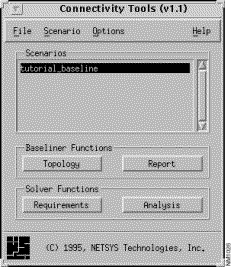
Step 2 Click on the Topology button in the Connectivity Tools window.
The tutorial_baseline scenario's topology is displayed in a campus IP view (the default) in the Topology window.
Step 3 Select the View>Flat menu option in the Topology window.
The topology is displayed in a flat, IP view.
Step 4 Select the Subview>IPX menu option.
Only the IPX routes are displayed in the Topology window.
Step 5 Select the Show>Object Labels menu option.
The network element names and/or address are displayed, as shown in Figure 11-2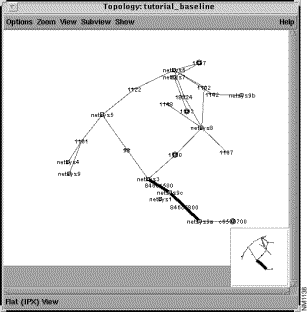
Step 6 Click on the Requirements button in the Connectivity Tools window.
The Requirement Sets window, as shown in Figure 11-3, is displayed. The Requirements button is used to create, view, load, unload, delete, and undelete end system IPX SAP connectivity requirements. 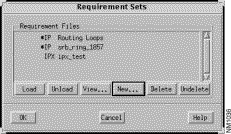
A list of existing connectivity requirement files is displayed in the Requirement Files list.
Requirement File entries preceded by an asterisk indicate connectivity requirements implicitly derived from the router configuration files. These connectivity requirement file sets can not be edited or deleted.
The implicitly derived Routing Loops requirement set is provided to find routing loops caused by IP redistribution. When you select the Routing Loops requirement set and then load it for analysis by clicking on the Load button followed by the OK button, a list of all the redistribution IP routing loops detected during analysis is displayed in the Requirements Analysis window. The results are a set of paths showing the identified routing loops. Each path displays a source address set to a port address of a router involved in the loop and a destination, which is a subnet or end point address, identifying the Routing Table destination involved in the routing loop. The path also shows a set of routers involved in a loop.
Step 7 Click on the New button.
The New Requirement Set window, shown in Figure 11-4, is displayed. A new set of protocol dependent (in this case IPX SAP) requirements are created and saved to the file specified in this window.
Step 8 Specify sap_test in the Name field.
A name must be assigned to the new set of IPX SAP connectivity requirements.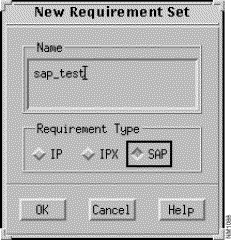
Step 9 Click on the SAP button, then click on the OK button.
Upon clicking on the OK button, the Requirements window is displayed. No entries are defined in the sap_test requirement set, therefore the Requirements pane is empty.
Step 10 Click on the Add button in the Requirements window to add new requirements to the sap_test requirements set.
The Add SAP Requirements window, partially shown in Figure 11-5, is displayed. For this tutorial, a SAP advertisement requirement from SAP server netsys8.ether1/2.0.es.ipx.1 (1107.0000.0000.0001) for SAP service File_Server to the netsys3 destination router is allowed.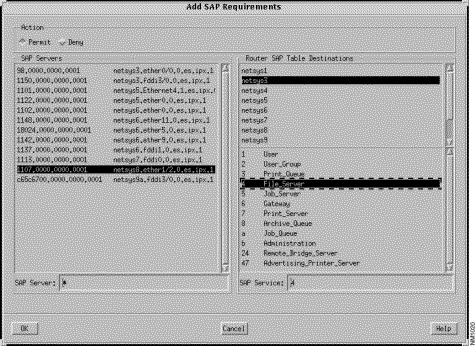
Step 11 Click on the OK button to add the new requirements.
The newly defined requirement entry is now added to the sap_test file as partially shown in the modified Requirements window in Figure 11-6.
Step 12 Click on the OK button to return back to the Requirements window.
The Requirement Sets window now displays the sap_test file name in the
Requirement Files list, as shown in Figure 11-7.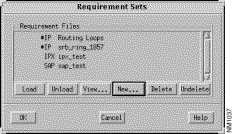
Step 13 Double-click on the newly created sap_test file entry in the Requirement Files list, then click on the OK button.
The sap_test file set requirements are loaded and analyzed. The results of the analysis are viewed from the Requirements Analysis window, partially shown in Figure 11-8. One existing path was found allowing the required SAP service advertisement connectivity requirement between an end system (netsys8.ether1/2.0.es.ipx.1) and a router (netsys3).
Step 14 Select the entry from this window to highlight the SAP path between the end system and the router in the Topology window, as shown in Figure 11-9.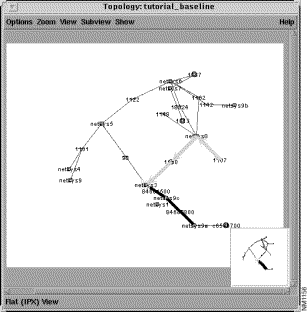
Step 15 Double-click on the selected connectivity requirement entry in the Requirements Analysis window.
A corresponding Round Trip Path window is displayed, as shown in Figure 11-10. This window provides the source end system name, address, service provided, and the name of the destination router.The current status of the path, and a list of the devices and network elements that make up the path from the source end system to the destination router are also displayed. Selecting an entry in the Round Trip Path list highlights that network component in the Topology window. Based on the information provided in this window and the Topology window, you are able to identify the current IPX SAP connectivity requirements you selected, not only from a component standpoint, but visually as well.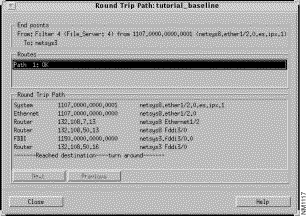
Step 16 Select the Scenario>Create New menu option in the Connectivity Tools window.
Create a new scenario (tutorial_baseline+). You can now stop the SAP Advertisement from being allowed to pass through an intermediate router along the path between the two end systems.
Step 17 Click on the Analysis button in the Connectivity Tools window.
The previously loaded SAP connectivity requirements are analyzed for the newly created scenario (tutorial_baseline+).
Step 18 Double-click on the netsys8 router icon in the Topology window.
The Router Configuration window, shown in Figure 11-11, is displayed. You can also use the Find Device feature to display the netsys8 Router Configuration window. 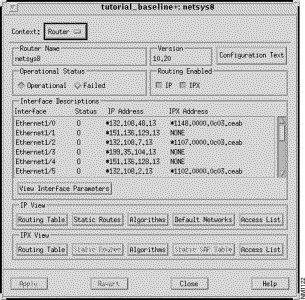
Step 19 Click on the IPX View Algorithms button.
The IPX Routing Algorithms window, shown in Figure 11-12, is displayed.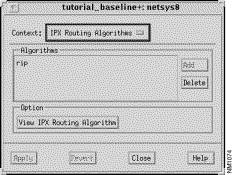
Step 20 Select the rip routing algorithm entry then click on the View IPX Routing Algorithm button.
The RIP Routing Algorithm window, shown in Figure 11-13, is displayed.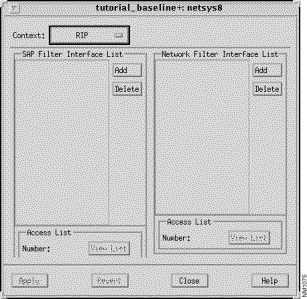
Step 21 Click on the Add button in the SAP Filter Interface List pane.
The Edit SAP Filter Interface List window, shown in Figure 11-14, is displayed. Create a SAP access list to block the SAP advertisement from end system (1107.0000.0000.0001) from going through the fddi3/0 interface on netsys8.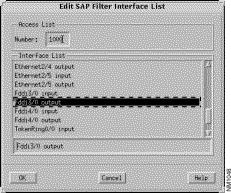
Step 22 Click on the OK button in the Edit SAP Filter Interface List window.
Step 23 Click on the Apply button in the IPX RIP routing algorithm window.
The SAP filter is added to the SAP Filter Interface List and is applied to the current netsys8 router configuration.
Step 24 Select the Fddi3/0 input entry in the SAP Filter Interface List, then click on the View List button.
The IPX SAP Filter List window, shown in Figure 11-14, is displayed.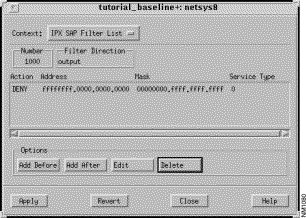
Step 25 Click on the Analysis button in the Connectivity Tools window.
Assess the status of the results from the Requirements Analysis window then check the Topology (Figure 11-16) and Round Trip Path (Figure 11-17) windows to see the new, highlighted path taken and the path's components.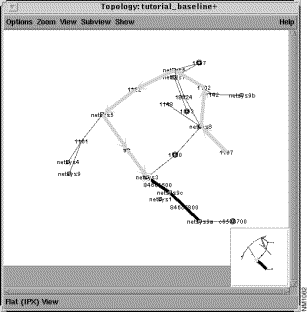
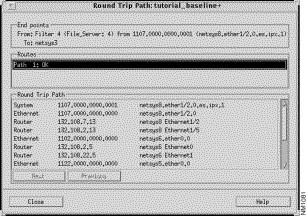
Step 26 Block the SAP advertisement from coming through the netsys5 router's Ethernet0 input interface by setting up a SAP Filter Interface List entry on the netsys5 router.
Refer to the previous steps for setting up the SAP filter on the netsys8 router to set up the SAP filter on the netsys5 router.
Step 27 Apply the changes, reanalyze, and view the results of the new scenario.
Notice there is no longer a path allowing the SAP service to be advertised at netsys8, as partially shown in Figure 11-18.
Step 28 Return to the netsys5 IPX Rip Algorithm window.
Allow the passage of the SAP advertisement to come through the netsys5 Ethernet0 input interface by modifying the existing SAP Filter Access List.
Step 29 Select the Ethernet0 input entry in the SAP Filter Interface List, then click on the Access List View List button.
The IPX SAP Filter List window, shown in Figure 11-19, is displayed.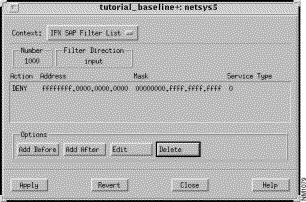
Step 30 Select the first entry in the list and then click on the Add Before button.
The Edit IPX SAP Filter List window is displayed.
Step 31 Click on the Permit button, then specify the Network address, and the Service Type (4) in their corresponding fields, as shown in Figure 11-20.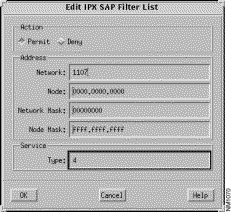
The IPX SAP Filter List window is updated to reflect the changes just made, as shown in Figure 11-21.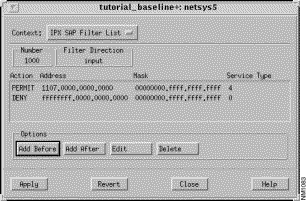
Step 32 Click on the Apply button in the IPX SAP Filter List window.
Step 33 Click on the Analyze button in the Connectivity Toolkit window.
Verify the result from the Requirements Analysis window and confirm the result in the Topology and Round Trip Path windows. Notice the path's status is now OK.
|
|